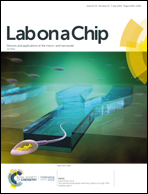Integrating user behavior with engineering design of point-of-care diagnostic devices: theoretical framework and empirical findings†
Abstract
With point-of-care (POC) diagnostic devices becoming increasingly available to untrained users, it will be critical to understand how real-world user behavior can best inform and guide the engineering design process. Social sciences present frameworks for analyzing user behavior, but they have not yet been applied to POC diagnostics in a methodical manner. Here, we develop a framework that synthesizes two models that can collectively account for user behavior and experience with POC diagnostic devices: a social psychological information-motivation-behavior (IMB) model (first described by Fisher and Fisher) for identifying determinants for health-related behavior, and user experience (UX) elements for studying interactions between users and products. Based on studies of 40 naïve users of our smartphone-enabled microfluidics device that can be used for HIV home-testing, we found that untrained participants could perform 90% of steps correctly, with engineering design elements that provided feedback that was either direct (e.g., a light or click) or binary (e.g., a switch) enhancing usability. Interestingly, of the steps performed incorrectly, over 70% were due not to errors in the device or user operation, but user-to-user variability (e.g. time in collecting fingerstick and force applied to initiate vacuum), which could be addressed by further modifications to the device. Overall, this study suggests that microfluidic POC HIV home-testing is likely to benefit from smartphone integration, and that engineering design of POC diagnostic devices can benefit from a structured evaluation of user behavior and experience, as guided by a social-psychological framework, which emphasizes user credibility, accessibility, acceptability, usability, and value.



 Please wait while we load your content...
Please wait while we load your content...